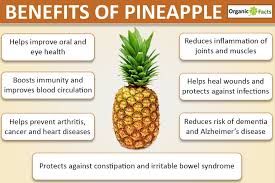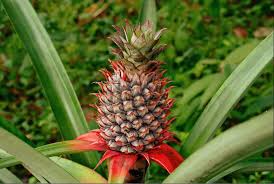ANANAS – THE NEW IMMUNE SYSTEM BOOSTER
Have you ever thought about pineapple being one of the best immune system protectors? I didn’t either but I have researched a lot in the meantime so I can come out with my personal observations on the long road of nutritional benefits and health contributions. It is not so easy to work on the immune system generally, because each of us has another genetical infrastructure and demands. Nevertheless, there are some characteristics that we all share and need and they should be analysed. In the age go constant health risks and emerging diseases, being healthy is the most important element of our daily life. This doesn’t mean only good diet and regularly workout but also the active development of the immune network of our bodies and empowering of the stations within us, that could be attacked and broken.
Why pineapple among so many other fruits? First of all, this tropical fruit deserves more attention than it really gets, because of its amazing health components. Second but not less crucial, the pineapple is low in calories and high in nutritional values that makes us stepping on the right stone for healthy food habits. It doesn’t matter if you are interested in boosting your immune system or simply shaping your diet, the pineapple should be and must be the ingredient of your menu.
This exotic fruit has been celebrated for centuries for its special taste and for great health benefits. According to some studies, the pineapple is the most important tropical fruit, after banana and orange. “The name pineapple evolved in the 17th century due to its structure and appearance being similar to pine cones.Eat a cup of pineapple chunks daily to reap some of its amazing benefits, such as boosting immunity, improving bone and eye health, aiding in digestion, and even accelerating weight loss. It is also anti-inflammatory in nature and helps in curing coughs and colds and accelerating weight loss.”
The ananas is known to be a great source of many vitamins, like vitamin A, C, beta-carotene, thiamin, vitamin B5, B6 and folate. Beside it, there are the following minerals: potassium, copper, manganese, calcium, sodium and magnesium. Such a cocktail of ideal values, makes the pineapple one of the most significant fruits in our book of nutrition. The combination of vitamin C and bromelain turn to be ideal for enhancing the immune system against immflamuation and different stages of viral infections and eventual illness of respiratory organs:“In order to check the impact of pineapple on immunity levels, almost 100 children were fed no fruit, some fruit, and lots of fruit daily in a nine-week study. Children who ate this fruit showed a lower risk of viral infections and had almost four times more white blood cells than the other two groups. This shows a positive association between pineapple consumption and increased immunity levels.”
The modern global health is fighting a difficult battle with cancer and so many people lose not only the battle but the whole war with this terrible disease. Based on the current studies, the uncontrolled cell growth and their malign progress is caused by oxidative stress and chronic inflammation. That is why is good to emphasise that pineapple reduces the risk of cancers. This exotic crown fruit is able to limit the oxidative stress through its enzyme, known as bromelain. This enzyme has been shown miraculous effects in the last years in clinical research due to the positive influence on the good cells and attacking the bad one or, at leats, suppressing them. This enzyme is not only famous for killing the cancer attempts but also for confronting the arthritis and helping the digestion. I found also very interesting the fact that pineapple can help us build a strong skeleton and prevent the degenerative bone disease. Regarding the eye health, the scientists confirmed that this fruit can improve the visibility and reduce the risks of macular degeneration of the eyes in the older ages.
The origin of the name is Spanish and comes from piña, back in 1398. Almost 300 years later, the name pineapple has been officially adopted in spite of fact that Europeans discovered this awesome fruit in 1493 on the Caribbean island of Guadalupe. They realised that they need special conditions so they can cultivate this fruit, used on tropical climate. The Portuguese and Spanish explorers are actually those people who brought ananas to the rest of the world. At the beginning, the fresh pineapple was a dream and the pineapple has been the sign of the higher class. In the meantime, American state of Hawaii learnt how to cultivate this fruit and how to make great export. Thailand, Philippines, China, Brazil and Mexico are also very famous in exporting this fruit to the rest of international community.
The pineapple is the necessary component in our diet and daily food habits but it is also relevant for gastronomy since there are many restaurants and cooking styles that include ananas in the delicious meals. The animal and pet industry is also living on processing pineapple in the food prepared for domestic animals and pets. The pharmaceutical sector is also interested in pineapple and tries to develop the effective medicaments, based on the bromelian, taken from this king of the tropical fruits.
There is no need for extreme consumption of this fruit, either because of the side effects that can be irritating. Overconsumption of the ananas means the higher level of vitamin C and bromealin within our bodies which can eventually cause the vomiting, swelling of mouth and cheeks, skin rashes or diarrhoea. As always, it is recommended the moderate use of this fruit, enough little to not bring problems and enough great to boost your immune network and your energy.
At the end, I would love to share one of my favourite pineapple smoothies from Sara Welch and Dinner at the Zoo:
INGREDIENTS
- 1 1/2 cups pineapple juice
- 1 banana cut in half
- 1 1/2 cups frozen pineapple chunks
- 3/4 cup vanilla Greek yogurt
- fresh pineapple wedges and mint sprigs for garnish optional
INSTRUCTIONS
-
-
Place the pineapple juice, banana, frozen pineapple and vanilla Greek yogurt in a blender.
-
Blend until smooth.
-
Pour into 2 glasses. Garnish with pineapple wedges and mint sprigs if desired.
-












What an inspirational and educational article, Sarah !
As a vegan, I eat a lot of fruits and vegetables. Adding pineapple would be so beneficial according to your article and research ! I buy pineapple, but not frequently, however, after reading your article, I sure will, henceforth !
We need as many antioxidants as we can in order to fight the free radicals which are responsible for oxidation which, in turn, causes cancer and the blockade of heart arteries, to name just a few diseases caused by free radicals !
In my case, I will substitute tofu for the Greek yogurt, as I’m vegan ! This looks delicious !
Thank you so much, Sarah, for this wonderful article !
LikeLike
Sarah’s informative and inspirational article reminded me of various aspects of the pineapple. For example, hummingbirds are the primary pollinators of wild pineapples; although, certain species of fruit bats pollinate them at night, as well.
Originally, the pineapple plant was indigenous to an area that became southern Brazil. The plant evolved over millions of years, but is among the most recent plants to have evolved on Earth. Most likely, it was a combination of pollinators and humans that spread the plant to Central America and The Caribbean Islands, where Mayans and Aztecs began to cultivate it.
However, the plant was not only used as a food resource: the Iberian Conquistadors of the 1500s took the red cultivar pineapple to various Spanish overseas possessions (e.g. The Philippines), where the long leaves of the plant became a source of traditional piña fibers; an adaptation of the native weaving traditions with fibers extracted from abacá.
These were woven into lustrous lace-like nipis fabrics decorated with intricate floral embroidery, known as ‘calado and sombrado’. The fabric was a luxury export from The Philippines during the Spanish colonial period and gained favour among the European aristocracy, in the 18th and 19th centuries.
Domestically, the leaves were used to make the traditional clothing of the Filipino upper class, as well as women’s kerchiefs (pañuelo). They were favoured for their light and breezy quality, which was ideal in the hot tropical climate of the islands.
LikeLike